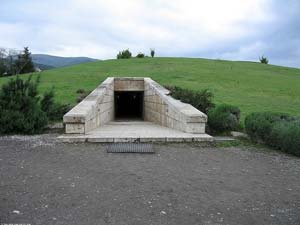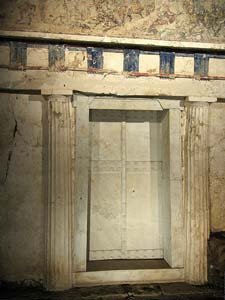At Vergina is one of those finds which archaeologists dream about – a well preserved discovery, proven association with a famous historical person, and real treasure! Ancient Aigai
Tombs & Palace
First described is the well-established find of the tombs. Followed by 2024 update on reconstruction of Palace of Aigai.
In 1977 the find was made by Professor Manolis Andronikos, who continued the excavations. Vergina is the modern village, and following the discovery the site was identified as Aigai, the ancient capital of the Macedonian kings, together with its cemetery.
And the reason for all this enthusiasm? A tumulus measuring about 110m wide by 13m high turned out to cover some tombs. Not just any old tombs, either. One of them was identified as that of Philip II of Macedon, the father of Alexander the Great. Another is thought to belong to Alexander IV, the son of Alexander the Great.

Unique treasures
But it wasn’t just the graves themselves which excited the archaeologists. It was the artifacts contained in them, together with wall paintings.
In order to preserve these priceless treasures an underground building was constructed in 1993 to protect the royal tombs. It also maintains the temperature and humidity at suitable levels to preserve the wall paintings.
As you approach you don’t even realise it’s a building, because it looks just like a normal earth tumulus. The authorities have come up with an excellent solution to both preserve the treasures found in the royal tombs and allow public access. Apart from the sepulchral monuments themselves, there is an open area of 1,000 sq.m., where the finds from the tombs are displayed in showcases.
What you can see
Some grave stelai were found, and you can see these together with artifacts used by ordinary people of Philip’s time. These show the different lifestyles of common folk and royalty.
The first tomb you come to is a large Macedonian tomb, almost contemporary with the others, which was found desecrated and completely destroyed.
Next is the Heroön, a building which was intended for the cult of the dead kings. This grave is important because it has a wall painting of the rape of Persephone by Pluto. Wall paintings rarely survive, and to find one in such a comparatively good state of preservation is remarkable.

The most important tomb is that of Philip II, the father of Alexander the Great. The facade has the form of a Doric temple, with a marble door, above which are stylised triglyphs and metopes. Above the Doric frieze is an Ionic frieze which is another painting of a hunting scene. Three horsemen and seven men on foot pursue a lion, deer, and boar. One of the men is mature and bearded, and experts think this is Philip himself. Another of the men is thought to be Alexander the Great.
This hunting scene and the Rape of Persephone are the only surviving examples we have of ancient Greek painting. They are thought to be the work of Philoxenes and Nikomachos.
In the burial chamber of Philip they found a marble sarcophagus, a gold larnax containing the ashes of the dead king and his crown inside it. There were weapons, a wooden mortuary couch which was decorated with gold, glass, and ivory.
After Philip was assassinated, his wife Cleopatra was also killed. In the antechamber of his tomb a larnax was found, with a royal diadem, a marble sarcophagus, and another wood couch. It’s thought that this is where she was buried.
The last tomb is thought to be that of Alexander IV, the son of Alexander the Great, and is very similar to Philip’s. Other items such as weapons, grave goods, vases, and another couch.
All these items are on display, which is why a visit to Vergina – ancient Aigai – is well worth considering.
Palace of Aigai: 2024 Update
Sorry, no copywrite free photos available yet. Search for AP photos. I did discover this:
The iron and gold cuirass of King Philip II of Macedon, father of Alexander the Great, 4th century BC, on display in Vergina, Greece.
byu/GreatMilitaryBattles inancientgreece
About 2km outside the town of Vergina are the remains of the royal palace and a theatre. It was in this theatre that Philip was killed. The palace also contains some well-preserved mosaic floors that just re-opened for view after a 16-year renovation that cost 20 million Euro.
The palace was built by Phillip II, Alexander The Great’s father, and is claimed to be the largest structure of ancient Greece at about 15,000 square meters.